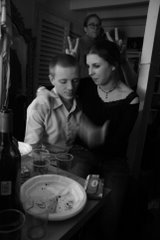About ten days ago, an estimated 2 million French workers went on strike and marched through the streets of France's cities. They were not protesting specifically about job losses like in England, nor only from the public sector which is often the case. This strike was about a more abstract sense of fear and helplessness due to the crisis and a hefty dose of anger directed at Nicolas Sarkozy. This was about the country's relationship with its president, the man who won the election on the promise that people would work more to earn more, that he would boot up people's disposable income, that he would modernise the French economy by basing it on a more flexible anglo saxon model, complete with low unemployment.
In retrospect, these election pledges seem both awkward, absurd and hilarious. Unemployment is soaring; purchasing power is collapsing; the French car industry, which indirectly employs 1 in 10 French workers, is close to collapse; and the banks have had to be bailed out. This last point has gone down especially badly with the French. As they struggle with inflaion and stagnant wages, reducing consumption in many cases to bare necessities, the government managed to magic up billions for the banks, seen by the population as inefficient, dangerous and corrupt. Despite Sarkozy's characteristic hyperactivity- he has been running around France giving huge conferences every two days on average- his now-ludicrous promises and idiotic remarks ("Hoho! Now when there's a strike in Frane nobody notices" he said at a public meeting, which was seen a pure provocation by the unions) have made him a resented and distrusted figure.
All he could do was respond. So he decided to give an interview, that would be shown on 3 channels simultaneously, in his offices at the Elysée. The two journalists, which he chose, are the newsreaders of the leading private and state channels, bit they didn't reallydo much, just let Sarkozy talk.
Sarkozy looks a bit older and more tired, and certainly wasn't as arrogant and lively as usual. He was, as always, fidgety but his voice had a grave and softer tone. On the crisis, he solemnly announced that this was the worst crisis in living memory and that there were no easy solutions. Not exactly the reassurance the population was after. He justified his plan to help the economy through investment and companies, rather than by encouraging consumption, which is what the UK have done by lowering VAT (and which the French socialists would like to do). He justified bailing out the banks because French savings were at stake, not the treacherous banks, which he is furious with. He went off into a little spiel about how he had "summoned the G20 to refound world capitalism" which sounded a little bigheaded. He then dropped a couple of shock factor proposals. First to arrange a huge meeting on the 18th of february with the Unions, the different interest groups and so on where they would discuss, among other things, cutting taxes for the poorer slices of the population (50% of French workers don't pay taxes already) and getting rid of the
taxe professionnelle, which represents 30% of companies' costs (but is also what funds local collectivities).
But behind the gravity and proposals, it was impossible not to notice a kind of megalomania: as well as the "I summoned the G20", there was also "I am your President, it is my role to protect you", "I went to wherever and did this", "I decided this and it was done". Amusingly, only when he suddenly came under fire for an unpopular measure unrelated to the financial crisis did he suddenly start saying that he didn't work alone, that he had a full council of ministers working round the clock and that he was absolutely not responsible alone for anything.
What came out of this was very little concrete measures. People had been expecting some emergency solution like Obama's $1000, but what they got was justification for saving the banks and helping companies, and a lot of Sarkozy saying that he would take on the crisis single handedly and not to worry. People are worried though. In the poll published today 52% of the French were unconvinced by his statements.






